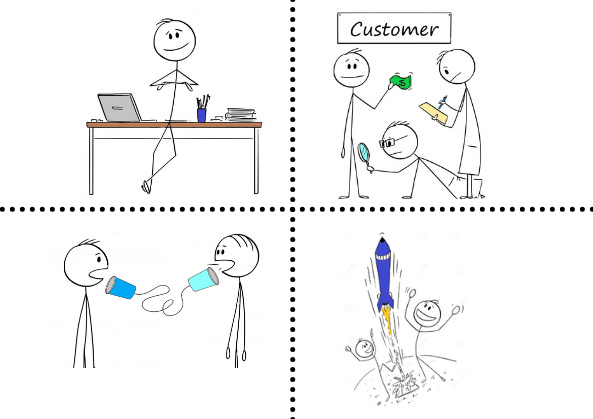Happy Thursday, 👋
Building a company is an exciting journey filled with creativity, ambition, and potential, but just because a founder says they are working on a startup doesn’t necessarily mean they’re making real progress. One of the most common traps of first-time founders is mistaking busyness for momentum. Founders can easily spend weeks designing a perfect logo, picking out a new laptop, or endlessly debating company names. While these tasks might feel productive, they rarely translate into actual business growth. Recognizing and addressing the difference between being busy and building momentum is crucial to understand.
Busy Does Not Equal Progress
The distinction between action and progress is subtle but critical. Designing a logo or setting up a workspace feels tangible and satisfying. The process provides immediate feedback and a sense of accomplishment. However, these tasks are comparable to organizing the cockpit of a rocket without ever starting the engine, essential but insufficient for takeoff. Real momentum is built through tasks directly connected to validating the core business idea, ensuring there's a genuine market, and verifying that industry and technological conditions are ripe for success.
Validate the Market First
Two questions investors often ask new founders:
🎯 What market validation have you done?
⚙ Has technology or society advanced enough to support your idea?
New founders may be surprised by these questions and realize they've skipped crucial steps like customer discovery, competitive research, or prototype testing. Effective market validation is not about seeking personal validation or casual reassurance from friends. Instead, it involves structured conversations with potential customers that challenge the viability of your idea.
Use the process of market validation to test your conviction as a founder. Approaching people and asking them if they would buy a product or service is not easy. Being nervous about the process is normal. But if you don’t feel a genuine passion to explain what you’re building, it might be a sign you're not pursuing the right idea. Launching a new company is difficult, so founders need to be truly invested in what they’re creating.
Beyond testing conviction, another benefit of market validation is that it helps refine your pitch. Talking to strangers about your idea requires a 30-60 second description of the product or problem you’re solving. Founders should take time to write out this description, practice delivering it aloud, and refine it based on feedback to ensure it's clear, engaging, and easy to understand. Your pitch should be simple enough that anyone can quickly grasp the business and its value, because the next step is asking them if they’d pay for it. The process is identical to developing your investor pitch. If potential customers cannot understand the product, it will be very difficult to get investors interested.
How to Properly Conduct Market Validation
To build momentum, founders should aim to talk to at least 50-100 potential customers. This number matters: fewer conversations typically reflect your immediate network and may not capture the broader market. The goal is market validation, not personal validation. When talking to potential customers, don’t just ask if the idea is "good" as most people will reflexively say yes. Instead, ask pointed questions like:
💸 How much would you pay for this product or service?
❔ What specific problem does it solve for you?
🛠 How are you currently solving these challenges? What works and what doesn’t?
Structured interviews help you identify genuine interest and willingness to pay. Ask each person for referrals to others who might benefit from your idea. This expands your validation pool beyond your initial network and starts forming a potential early customer base.
Evaluate Industry and Technological Viability
Even strong market validation isn’t enough. Founders must also assess whether their idea is technologically and commercially feasible. History shows that innovation must also have the right timing. Bell Labs demonstrated the first video call in 1927, but it took another 80 years before widespread broadband provided 100 million users easy access to the technology. Technological and societal readiness can mean the difference between breakthrough success and premature failure.
Evaluate whether the necessary technologies and industry ecosystems exist to support your idea now. If your analysis shows that it’s too early, that’s perfectly fine. Great entrepreneurs often maintain a list of ideas, waiting patiently for the right moment.
Final Thoughts: Shift from Busy to Momentum
Once you've confirmed both market interest and industry feasibility, you've started building real momentum. Unlike merely being busy, this momentum moves your company forward with purpose. It provides actionable data, customer insights, and clear next steps for development.
With this foundation, your conversations change. Instead of talking about an idea, you’re sharing data, validation, and insight. Suddenly, you’re not just spinning your wheels, you’re laying down real traction and building something that moves forward.
Investors are naturally skeptical. But when you’ve completed these first few steps, validating the market and evaluating industry readiness, you give them a reason to lean in. It shifts their mindset from fearing investment risk to fearing they’ll miss out on a great opportunity.
Every rocket needs an organized cockpit, but at some point the real test is pressing the ignition. For founders, that ignition moment is real-world validation. It marks the transition from idea to action, from theory to traction. It’s when you stop preparing and start building.
Wishing everyone a great weekend,
-Eric.



